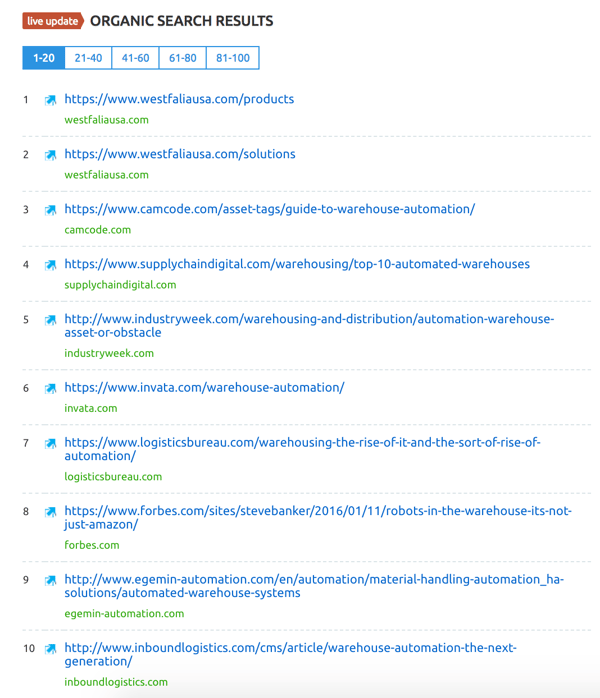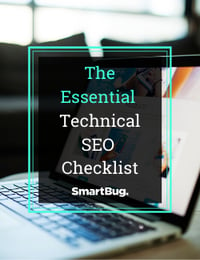
14 SEO Mistakes to Avoid During a Website Redesign
November 2, 2018
By Paul Schmidt
Redesigning a website can be a huge project, with hundreds of technical, financial, creative, operational, and strategic decisions to think through. From planning out your goals to building your site from the ground up, it can take months of planning, designing, writing, and developing before you can show off your masterpiece to the world.
One key to making sure your launch goes off without a hitch is to ensure your website speaks the language of search engines—or SEO. How do you make sure that any SEO value you’ve built up with your old website is not only retained, but also enhanced on your new website? Here are 14 SEO mistakes to avoid when redesigning your website.
Mistake #1: Redesigning Without Goals
Before you start designing or mapping out content, you need to ask yourself:
- What are the primary goals and objectives for this new website?
If you plan to use your website to generate sales leads, your content and user experience need to align with your conversion paths, helping to nurture visitors into leads. This is a key element of inbound marketing programs. To find leads, you’ll want to generate awareness by increasing traffic. This means more blogging, premium content creation, social sharing, and creating reasons to keep people coming back. There is no one-size-fits-all website. When discussing a redesign with your team, think through these core elements:
- Goal of redesign: What does success look like in three to six months?
- Personas: Who are your ideal customers? Depending on your business, you may have several types of ideal prospects.
- Buyer’s journey: What are the core phases that a prospect experiences when making a decision to purchase a product like yours?
- Key elements: What are must-have features and components to help us accomplish our goals?

Mistake #2: Not Capturing Benchmarks
Now that you’ve made the decision to redesign your site, you should establish metrics based on the performance of your old website. These analytics benchmarks can be found in HubSpot or Google Analytics and will help you set goals for the new site, as well as for overall business growth.
Types of benchmarks include:
- Time spent on site, overall visits, and average banner click-through rates: These are of particular concern to B2B publishers who monetize based on ad revenue.
- Visitors to sales conversions of a certain product: A B2C company might only care about turning visitors into customers, and focus the entire user experience toward this right away.
- Lead generation: A service-based organization may be more concerned with generating leads for their sales team, and thus, spend more time educating and raising awareness outside of its brand.
From an SEO perspective, in order to retain link equity and any value you’ve built on your current domain, you’ll want to benchmark at least these metrics:
- Total traffic (from organic search, referrals, and so on)
- Conversion rates (ideally each step between traffic and customers)
- Which pages are getting organic traffic (usually mapped to the best keywords)
- Usage metrics (geography, bounce rate, time on site, and so on)
- Inbound links (the sites that are linking back to you)
Mistake #3: Choosing the Wrong CMS and Hosting Provider
The right content management system (CMS) is perhaps the single most important factor for a website. Depending on the scope of your new site, you’ll have to weigh cost, functionality, support, security, reliability, and speed.
A few features in CMS you should be looking for to ensure a perfectly optimized website are:
- Responsive design: The website should work seamlessly across any computer, tablet, mobile device, or browser. Google specifically calls this out as an SEO signal.
- Functionality: Does the CMS allow you to adjust the website and add the right meta tagging or rich schema that search engines use to understand the layout, context, and content of your website?
- Analytics: Does the CMS allow you to add analytics functionality or have analytics functionality built in? It’s important that you are able to easily track visits, leads, bounce rates, time on site, and user flows, and build custom reports to answer specific marketing questions.
- Support: Do you have access to a support team or an online community if an issue comes up with the CMS? More obscure CMSes are likely to have limited documentation or costly customer support. Keep this in mind because it could be an added cost.
- Speed: Search engines use site load speed as a ranking factor. Make sure your website is using an up-to-date CMS with a fast hosting provider. We recently migrated a website to HubSpot (which has a lightning-fast hosting provider) and saw an overnight improvement in rankings.
Mistake #4: Improper Use of Redirects
Redirects are important when redesigning your site if you have to change URLs. Redirects are commands that tell search engines where to find content that is no longer at a specific URL. One of the more common SEO mistakes is either using 302 (temporary) redirects, or even using 301 (permanent) redirects the WRONG way.
What if I have to eliminate pages from my old site? In this case, redirect your old page to the most relevant new page with similar keywords. For example, if you are a bank and are eliminating a certain financial product page, then redirect that old URL to the main financial product category page or a similar product page. This is a much better option than just sending people to your homepage or your blog.
Mistake #5: Not Submitting a Sitemap
Every website should submit a sitemap to search engines like Google, Bing, and Yahoo. These can be submitted through the respective search engine’s webmaster tools feature. A sitemap shows the URLs for your entire site and helps search engines understand the organization of your website.
Mistake #6: Not Telling Search Engines About Your Domain Change
Just like you tell the post office when you’re moving, you need to tell search engines like Google that your new website is no longer the same. In addition to submitting your new sitemap, use the change of address tool in the Search Console for Google to give them an update.
Here are the 3 steps to submitting your change of address to Google:
- Step 1: Move your content over to the new domain.
- Step 2: Verify Google Search Console on the new domain.
- Step 3: Submit your change of address in Google Search Console.
Mistake #7: Not Using the Knowledge Panel or Schema Markup
Fifty percent of search results get a knowledge panel result on Google. This is up from 25 percent just two years ago! We can expect this percentage to rise, especially for businesses. Knowledge panels provide key information that users often seek. Google’s data highlighter tool helps you you explain how your data is structured across your website so Google can use these within rich snippets. The data highlighter supports the following:
- Articles
- Events
- Local Businesses
- Restaurants
- Products
- Software Applications
- Movies
- TV Episodes
- Books
Another way to get your results in the knowledge panel is the more explicit use of rich schema. Rich schema is an HTML markup that tells search engines specifically what a piece of HTML is communicating to your website visitors.
Mistake #8: Accidentally Blocking Search Engines
Your robots.txt file is how you can instruct crawlers to avoid indexing specific sections of your website. Called the Robots Exclusion Protocol, it publicly tells search engines how to read your website. Your robots.txt file can be found at www.YourDomain.com/robots.txt.
Staging pages, internal pages, and simple thank you pages are some of the most common pages you’d block from search engines. On your new website launch date, make sure your website domain is not listed within robots.txt.
If you want search engines to crawl your entire website, make your robots.txt page read:
User-agent: *
Disallow:
Sitemap: http://www.yoursite.com/sitemap.xml
Mistake #9: It’s Not Easy to Share Content
Social sharing improves overall traffic and awareness of your content. It also generates more links to your website and encourages conversations about your brand and/or products. All of these increase your SEO success. Make it easy to share your content by following these three simple steps:
- Step 1: Make your content shareable in the first place. Remember, people generally share something they endorse or stand behind. Make sure your content is interesting, valuable, and not overly sales-focused.
- Step 2: Make it aesthetically pleasing. Use graphic design, engaging photographs, or videos. Use a clear catchy title, description, and large image in your posts.
- Step 3: Use other best practices like social buttons and mimic shareable websites like Buzzfeed and Wired.
Mistake #10: Not Using Secure Hosting (HTTPS)
Bad security practices are detrimental to SEO. Search engines will remove your website from their index if your website has been hacked. Make sure your CMS has the right security built in or you are using a security plug-in to avoid this.
Some browsers draw the visitors’ attention to a non-secure warning if your website is not using secured hosting. Here are some examples of what this looks like:


As of April 2017, 50 percent of first page results were on https, so webmasters are definitely taking a hint that this is important for their users and their websites’ ability to rank.
Mistake #11: Gathering Poor Qualitative Insights from Your Audience
A lot of assumptions are made when building a website. For startups who are still trying to gain product-market fit, this is especially true. Before your next website build, budget extra time to gather 10-20 interviews from current customers and prospects.
Don’t assume that because you are an expert in your field, you know exactly how users navigate the web to make a purchasing decision. Within each of your interviews, have your interviewee walk you through every step they took as they went through their buying process. The process likely starts way before they land on your website. Here is one of my favorite books on conducting these interviews.
If you don’t have many customers or prospects yet, there are several fairly priced user research tools you can use to gather intelligence like Google Surveys or SurveyMonkey Panels.
Mistake #12: Not Conducting Competitive Analysis
How will you know what pages to build, what keywords to target, and how to rank highly for your industry topics? Competitive intelligence.
Competitive intelligence is extremely helpful prior to building your new website because you can focus on the types of user experience, content, and features that Google already values within top ranking content.
Let’s take a look at an example of company trying to rank for “warehouse automation.”
Here are the top 10 sites ranking on Google U.S. for this term:

(source: SEMrush)
As you look through these sites, identify the qualitative and quantitative patterns that help your competitors outperform you in search. Some elements you should be looking for in thinking about your own website are:
- Content depth: Do they have several pages on their site devoted to this topic or one longer, in-depth page?
- Content formats used on these sites: Video, long-form text, audio, interactive.
- Quantity/quality of linking domains to these sites: You can’t really impact this much from a website redesign perspective, but it will give you an idea of how much effort will be needed to rank over time for more competitive terms.
- Quality of mobile design: Some industries benefit from having a much different experience on mobile than on desktop.
Don’t make the mistake of redesigning your website in a bubble.
Mistake #13: Poor Keyword Optimization, Discovery, and Targeting
There are hours of work that go into content creation, design, analytics, and strategy before launching a site. Keyword research is one of the best places to start in order to ensure content is seen by search engines. Keywords should:
- Reflect your buyer personas and buyer’s journey.
- Use key phrases that reflect pain points, goals, challenges, and non-branded terms.
- Relate to a topic cluster that will allow you build out related blogs and web pages.
Keyword research has a big impact on SEO. Using your keyword list, you’ll want to optimize the following pieces of each webpage:
- URL
- Title
- Meta description
- H1 header tag
- Body copy
- Image alt-text
- Internal links from other websites (ideally)
- Video descriptions
At SmartBug, we like to use a few different tools for keyword optimization and discovery:
- Google AdWords Keyword Tool: A great resource for finding recommendations for new keyword categories and better understanding your overall rankings and opportunities.
- Moz’s Keyword Explorer Tool: One of our favorite tools that can provide hundreds of keyword suggestions, as well as identify keyword difficulty, opportunity, and more.
- SEMrush: One of the most important keyword discovery exercises you can do is mapping out your keywords by topic. You can do this by going through your keyword list and mapping each keyword to a topic. It’s a bit of a manual process but by the end you’ll have a list of 500-2,000 keywords all mapped to a fixed grouping of topics. SEMRush makes this a breeze because you can export all of your competitors’ ranking terms and then go through each brand one by one to understand the types of topics they prioritize and what pages you should be sure to add as part of your redesign.
Mistake #14: International SEO and Only Designing for Your Home Country
We work with clients around the globe that are trying to reach new audiences each day through search. When redesigning your site, make sure you let search engines know how specific visitors should be accessing your website. A few elements for you to incorporate on your website are:
- Hreflang: This is a directive to search engines to tell them to show a specific version of your content based on the language the user has as default within their browser.
- Google Search Console: GSC allows you to tell search engines if one of your top-level domains is targeting a specific country. If you are using multiple TLDs for your website, make sure each TLD has a Google search console account associated with it.
- Localized keyword targeting: Even though users in multiple countries speak the same language, the way they talk about and spell your product can be different. Make sure to use an international keyword research tool and speak with your local customers, so you can identify the nuances between countries.
If you’re just starting to explore international SEO, here is a great guide to learn more.
This blog was originally published May 2017 and has been updated since.

About the author
Paul Schmidt is a director of client services at SmartBug Media. He works with clients on SEO, analytics, lead generation, sales enablement, customer success and inbound marketing strategy. He previously worked at HubSpot, helping develop inbound strategies for over 200 clients. His past clients include: Travelers Insurance, Unilever, and the SABIAN Cymbal Company. Paul studied percussion in Las Vegas and got his MBA in marketing in Boston Read more articles by Paul Schmidt.




















